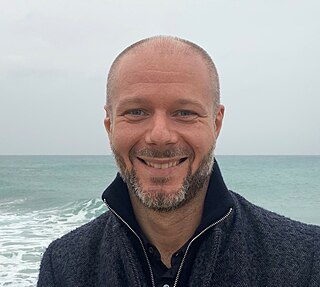
Hydrology is the scientific study of the movement, distribution, and management of water on Earth and other planets, including the water cycle, water resources, and drainage basin sustainability. A practitioner of hydrology is called a hydrologist. Hydrologists are scientists studying earth or environmental science, civil or environmental engineering, and physical geography. Using various analytical methods and scientific techniques, they collect and analyze data to help solve water related problems such as environmental preservation, natural disasters, and water management.
In hydrology, discharge is the volumetric flow rate of a stream. It equals the product of average flow velocity and the cross-sectional area. It includes any suspended solids, dissolved chemicals like CaCO
3(aq), or biologic material in addition to the water itself. Terms may vary between disciplines. For example, a fluvial hydrologist studying natural river systems may define discharge as streamflow, whereas an engineer operating a reservoir system may equate it with outflow, contrasted with inflow.
Robert Elmer Horton was an American hydrologist, geomorphologist, civil engineer, and soil scientist, considered by many to be the father of modern American hydrology. An eponymous medal is awarded by the American Geophysical Union (AGU) to recognize outstanding contributions to the field of hydrological geophysics. The AGU Hydrology section was formed largely due to his personal property that was bequeathed to AGU.
Runoff is the flow of water across the earth, and is a major component in the hydrological cycle. Runoff that flows over land before reaching a watercourse is referred to as surface runoff or overland flow. Once in a watercourse, runoff is referred to as streamflow, channel runoff, or river runoff. Urban runoff is surface runoff created by urbanization.

The law of water balance states that the inflows to any water system or area is equal to its outflows plus change in storage during a time interval. In hydrology, a water balance equation can be used to describe the flow of water in and out of a system. A system can be one of several hydrological or water domains, such as a column of soil, a drainage basin, an irrigation area or a city.
Generalized likelihood uncertainty estimation (GLUE) is a statistical method used in hydrology for quantifying the uncertainty of model predictions. The method was introduced by Keith Beven and Andrew Binley in 1992. The basic idea of GLUE is that given our inability to represent exactly in a mathematical model how nature works, there will always be several different models that mimic equally well an observed natural process. Such equally acceptable or behavioral models are therefore called equifinal.
Geographic information systems (GISs) have become a useful and important tool in the field of hydrology to study and manage Earth's water resources. Climate change and greater demands on water resources require a more knowledgeable disposition of arguably one of our most vital resources. Because water in its occurrence varies spatially and temporally throughout the hydrologic cycle, its study using GIS is especially practical. Whereas previous GIS systems were mostly static in their geospatial representation of hydrologic features, GIS platforms are becoming increasingly dynamic, narrowing the gap between historical data and current hydrologic reality.

A hydrologic model is a simplification of a real-world system that aids in understanding, predicting, and managing water resources. Both the flow and quality of water are commonly studied using hydrologic models.
The International Association of Hydrological Sciences (IAHS) is a non-profit, non-governmental scientific organization committed to serving the science of hydrology and the worldwide community of hydrologists. The IAHS was established in 1922, and presently claims a membership in excess of 9,000 with members in over 150 countries.
The following outline is provided as an overview of and topical guide to hydrology:
DPHM-RS is a semi-distributed hydrologic model developed at University of Alberta, Canada.
In hydrology, routing is a technique used to predict the changes in shape of a hydrograph as water moves through a river channel or a reservoir. In flood forecasting, hydrologists may want to know how a short burst of intense rain in an area upstream of a city will change as it reaches the city. Routing can be used to determine whether the pulse of rain reaches the city as a deluge or a trickle.
The topographic wetness index (TWI), also known as the compound topographic index (CTI), is a steady state wetness index. It is commonly used to quantify topographic control on hydrological processes. The index is a function of both the slope and the upstream contributing area per unit width orthogonal to the flow direction. The index was designed for hillslope catenas. Accumulation numbers in flat areas will be very large, so TWI will not be a relevant variable. The index is highly correlated with several soil attributes such as horizon depth, silt percentage, organic matter content, and phosphorus. Methods of computing this index differ primarily in the way the upslope contributing area is calculated.

Murugesu Sivapalan is an Australian-American engineer and hydrologist of Sri Lankan Tamil origin and a world leader in the area of catchment hydrology. He is currently the Chester and Helen Siess Endowed Professor of Civil and Environmental Engineering, and professor of Geography & Geographic Information Science, at the University of Illinois, Urbana-Champaign. Sivapalan is widely recognized for his fundamental research on scale issues in hydrological modeling, his leadership of global initiatives aimed at hydrologic predictions in ungauged basins, and for his role in launching the new sub-field of socio-hydrology.

Professor Günter Blöschl is an Austrian hydrologist, engineer and academic.
Elizabeth Mary Shaw was a British hydrologist and author of the popular textbook Hydrology in Practice.
Danny Lee Fread was an American hydraulic engineer and Senior Research Hydrologist, best known for his computer-based mathematical simulation programs for rainfall and runoff to forecast the flow of flooding rivers and dam failures.

Giuliano Di Baldassarre is a professor of hydrology at Uppsala University and the Director of the Centre of Natural Hazards and Disaster Science, Sweden. He was awarded the American Geophysical Union Whiterspoon Lecture in 2020 and the European Geosciences Union Plinius Medal in 2021.

Ezio Todini is an Italian academic, hydrologist and civil engineer.
Richard M. Vogel is an American hydrologist and environmental engineer and professor emeritus in the department of civil and environmental engineering at Tufts University.








